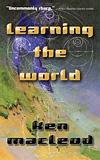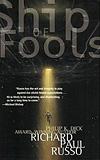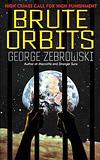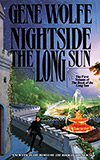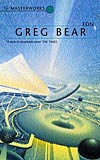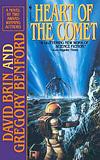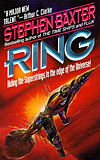NASA Dreams of a Hundred-Year Starship
 I recently read an article about a joint NASA/DARPA project called the "Hundred-Year Starship". Basically, it’s a year-long study to determine the feasibility of constructing a generation ship for the purpose of colonizing a suitable planet outside our solar system. According to Paul Eremenko, project coordinator at DARPA:
I recently read an article about a joint NASA/DARPA project called the "Hundred-Year Starship". Basically, it’s a year-long study to determine the feasibility of constructing a generation ship for the purpose of colonizing a suitable planet outside our solar system. According to Paul Eremenko, project coordinator at DARPA:
"The 100 Year Starship study is about more than building a spacecraft or any one specific technology. We endeavor to excite several generations to commit to the research and development of breakthrough technologies and cross-cutting innovations across a myriad of disciplines to advance the goal of long-distance space travel, but also to benefit mankind."
Could NASA pull off anything as awesome as all that? Even with DARPA’s help? Well, let’s just say I’m with Capt. Xerox on this one. He sums it up nicely for me:
"I wouldn’t go betting any money on this program actually happening. NASA hasn’t been back to the moon in a generation, never mind heading beyond the solar system…"
Bottom line? Not bloody likely. So says my rational mind anyway.
My geeky SF brain, however, refuses to let go of the notion. I’ve been reading about generation ships and extra-solar colonization forever. The technological wonder of a massive starship with a complete enclosed ecosystem hurtling through space for a hundred years, taking its precious cargo of humanity across the void in search of another Eden? Entire generations of inhabitants living aboard a ship that is the only home they’ve ever known? Never to see the Earth again? That’s the stuff of dreams.
And of course astronomers have been finding new planets at an astonishing pace. How long before they find one worth visiting? Will we be ready to go when they do? How far out would we have to start planning something like that to ever make it a reality? I’d say pretty damn far. So far, in fact, that it sounds like science fiction. Kind of like now. I can’t tell you how excited I am just knowing that there are real scientists out there actually considering this idea; especially at a time when it seems that we’re moving further and further away from the promise of manned space flight.
I say keep on dreaming big, NASA! It has to start somewhere, sometime. And even though it likely won’t happen in our lifetimes there are plenty of us out here who will go right along dreaming with you.
Would you like to know more?
- NASA Ames’ Worden reveals DARPA-funded ‘Hundred Year Starship’ program
- 100 Year Starship: Nasa’s plan to colonise galaxy
- ‘Hundred-Year Starship’ Would Send Space Explorers on One-Way Mission to Mars
- NASA and DARPA Plan ‘Hundred-Year Starship’ To Bring Humans to Other Worlds and Leave Them There Forever
Generation Ship Novels
Until there’s a real ship to take us "where no man has gone before" we’ll have to make do with some great science fictional accounts of what it might be like:
What other great generation ship novels can you think of?
Real “Worlds Without End”
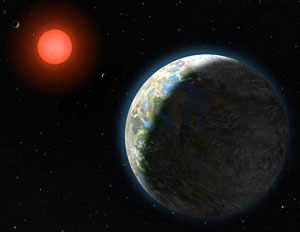 Space.com is reporting that the 500th alien planet could be discovered this month. There are currently 494 confirmed extrasolar planets on the books and, at the rate they’re being discovered, it is expected that number will top 500 by the close of October.
Space.com is reporting that the 500th alien planet could be discovered this month. There are currently 494 confirmed extrasolar planets on the books and, at the rate they’re being discovered, it is expected that number will top 500 by the close of October.
What’s more, with new technologies like NASA’s Kepler spacecraft the rate of discovery is only going to go up. Kepler has already found 7 new planets and has identified over 700 candidate stars that may have planets.
"Researchers are following up on these promising leads, trying to rule out any false alarms. They’re checking out the candidates with ground-based instruments as well as orbiting assets like the Hubble Space Telescope and the Spitzer Space Telescope.
When such work is done, the number of known alien worlds could increase by several hundred — and it could happen soon."
Worlds Without End, indeed!
Science Fiction is Now
In so many ways, classic science fiction authors predicted technologies that are in everyday use now. Think Star Trek communicators and everyday cellular flip phones.
The most recent example of sci-fi becoming sci-fa(ct) is already out. In Vernor Vinge’s latest, Rainbows End, children are depicted playing their videogames not in their living rooms in front of the television, but outside. I work for a co-op dedicated to getting people (especially children) outside, so you can imagine how delighted I was at the prospect of technology that actually takes you outdoors. The technology in this book, however, might leave a parent wistful for the antiquated yet charming x-box days.
The tech works like this: Everyone (well, not everyone, but everyone who is anyone) in Vinge’s world views their surroundings with enhanced vision. A virtual layer is superimposed on the world with a contact lens display screen. Forget CRTs being replaced by LCD. There is no need for a computer screen because displays now live under your eyelid. Sound far fetched? It’s being done.
The contact lens, however, is just another interface. As amazing as this technology seems to us, it will be taken for granted in short order. The real technology power will be in the hands of programmers. Vinge predicts whole virtual worlds that will be experienced not in dimly lit apartments (a la Nueromancer), but in the light of day. The students of fictional Fairmont High (at least the ones who actually show up to class rather than attend virtually, which they can do) run outside to recess and play games outside and layer virtual worlds over real objects to create adventure. Would you like to do that now?
You can. The guys at Groundspeak have been developing an interactive gaming system called WhereIGo with a functionality that harkens back to Zork. Garmin’s latest handheld GPS, the Colorado, is the first GPS device capable of running this program, although can also use a GPS enabled palm unit. So, think back to when you played Zork in 1980. For those of you who weren’t around (or perhaps were around but weren’t quite the geek I was) in 1980, Zork was text based game. You start out in a room with several doors. You navigate the game by inputting simple commands like “exit left doorway” or “open treasure chest”. Even later games like Doom or Quake were merely graphically enhanced versions of Zork. WhereIGo makes the great outdoors your virtual world by using a GPS interface like the Colorado. Instead of inputting those kludgy sentences (like Zork) or using a joystick (like today’s games), you input your virtual actions by actually moving around in the world. I am currently working on adapting these games for REI. Soon, you will be able to play these games at local stores (you already can at the Seattle and Portland locations). Here’s what a WhereIGo enable Colorado looks like:
So, here’s an example. A programmer goes to a local park and starts to input data. The big oak tree in the middle of the park can be anything in the game. When you go to that tree, something will happen in the game. Perhaps there is a street sign that can provide a clue that you might need in the game. The only way to continue playing would be to go get that clue. Since the Colorado is a GPS, the game knows where in the game you are.
Games like WhereIGo are in their primitive stage, at the moment, but give the programmers some time, and they will create a rich world that can easily be ported through something like those contact lens displays.
That virtual world is coming fast.



















 Full Details
Full Details
